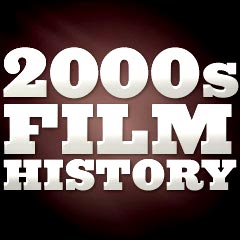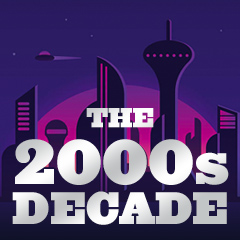 |
The 2000s The New Millennium, an Age of Advanced Special Effects (CGI and Performance Capture) and the Era of Franchise Films Part 3 Film History of the 2000s Part 1, Part 2, Part 3, Part 4, Part 5, Part 6 Film History by Decade Index | Pre-1920s | 1920s | 1930s | 1940s | 1950s | 1960s 1970s | 1980s | 1990s | 2000s | 2010s |

|
|
An Era of Documentary Films: Also, documentary films were met with significant interest for the first time --
Michael Moore's controversial tirade against the Bush administration, its 'war on terror', and government corruption, Fahrenheit 9/11 (2004), won the top prize, Palme D'Or, at the Cannes Film Festival, making it the first US documentary to win the award. At the time of its release, it also broke the record for highest opening-weekend box-office earnings in the US for a documentary, and established a significant precedent for a political documentary by being the first ever documentary to cross the $100 million mark in the US (eventually earning $119 million). Disney's refusal to let Miramax release it actually contributed to the film's great success. Moore's film set box-office records as the highest-grossing non-concert, non-IMAX documentary film of all time. However, the film's diatribe against President George W. Bush wasn't able to prevent his re-election in 2004.
Al Gore's climate change, global warming expose An Inconvenient Truth (2006) grossed $24.1 million - setting a record as the third-highest grossing non-IMAX/concert political documentary ever made (at the time). It was nominated for two Oscars and won both: Best Original Song ("I Need to Wake Up" by Melissa Etheridge), and Best Documentary Feature. Horror Films: Cheaply-Made Retreads Film making studios realized that lucrative profits could be scored by cheaply remaking, adapting, or 're-treading' classic TV shows or most prominently - horror films. Horror became one of the most profitable genre franchises in the new century - these films were low cost to produce; didn't require much originality, big-name (and salary) actors or extensive marketing (because of brand-name recognition); and they were capable of attracting large audiences, often ready-made legions of faithful horror-film devotees. One thing most of the films had in common - they were not favorites of the film critics. Many were watered-down, familiar films without any further originality. Examples included:
And horror franchises of this kind could be extended almost indefinitely, for example:
It was back and forth as to the highest-grossing horror series in film history. The gory series of 7 Saw films with a total domestic gross of $415.9 million, finally surpassed the Friday the 13th series of 12 films (with a total domestic gross of $380.6 million). Horror Films: Remaking Japanese Horror Films One of the trends in the popular genre of horror films was to remake Japanese horror films, culminating in retreads of successful foreign classics. The most effective, intelligent and stylish horror film of the new decade was Gore Verbinski's The Ring (2002) - a modern-day, gothic horror classic, a remake of the Japanese horror flick Ringu (1998). Other horror films were retreads of successful foreign classics (i.e., The Grudge (2004) (with two sequels in 2006 and 2009) and Dark Water (2005)). Horror Films: The Growth of 'Torture/Gore-Porn' Another trend in horror films was to make variations of the sadistic, low-budget "trash" horror Z-films of the 1970's, many of which featured rape-revenge themes, as in Wes Craven's crude The Last House on the Left (1972), and Meir Zarchi's brutal Day of the Woman (1978) (aka I Spit on Your Grave). This genre of so-called "pseudo-snuff films" (dubbed "horror-porn," "torture-chic," "gore-nography," and "claustrophobic cruelty") was accused of being like a "sicko video game" - containing visceral violence and unheard-of human suffering - that severely tested the limits of R ratings. However, in this new century, film audiences' threshold for sadistic and excessive gore, body mutilation, torture, and sickening violence had already been numbed by years of 'slasher' films, and this new crop of low-budget "trash" horror scarefest films was often tolerated and embraced by horror fans:
In some ways, the torture stories of the decade's headlines during the 'global war on terror' (waterboarding, Guantanamo, prisoner abuse and torture in the Abu Ghraib prison of Iraq, etc.) were reflected in these films. A new variation on horror films was the blending of 'chick-flicks' with a traditional horror-adventure film, exemplified by Lions Gate's claustrophic and terrifying The Descent (2005, UK) - one of the first all-female brutal action horror films. This little British production from director Neil Marshall told about six athletic, extreme cave-plunging spelunkers (six unknown actresses) who faced various horrors (predatory humanoid underground dwellers) in the thick darkness of an Appalachian cavern - without any instances of nudity, gratuitous body shots, or sex. New Blockbuster Benchmarks:
One of the most recent records to be broken was for budget/production costs, when Pirates of the Caribbean: At World's End (2007) became the most expensive picture ever made at $300 million. Routinely, however, many 'event' films cost $200 million. And for only the fifth time in all of film history, a film has reached $1 billion at the box-office (worldwide) - James Cameron's Avatar (2009). At the end of 2009, the domestic yearly box-office gross total topped the $10 billion mark (at $10.6) for the first time ever. Prognosticators were anxious to see which films would break further benchmarks, with possible clues from past top-performing examples. The Decade's Steady Stream of Box-Office Blockbusters and Sequels: The decade spawned many new blockbuster series (or franchises), sequels, serials, or reboots, often featuring comic-book superheroes, fantastical tales (based on previous novels by Tolkien, J.K. Rowling, and C.S. Lewis), CGI-animated characters, or action-thrillers. It could easily be said that some of the biggest films of the decade were based on adaptations of previous artistic works:
Many of these huge money-making franchise-blockbusters were the top-grossing films of their individual years in the decade:
In just one year, 2002, three of the four top-grossing films (domestic) were franchise sequels: The Lord of the Rings: The Two Towers (2002), Star Wars Episode II: Attack of the Clones (2002), and Harry Potter and the Chamber of Secrets (2002). The number one film of the year Spider-Man (2002) had its own profitable sequels in 2004 and 2007.
Many of the biggest blockbuster film franchises of the decade did not receive high marks for film-making quality, with some exceptions (The Lord of the Rings trilogy, the first Shrek film, etc.). Some of the factors that could spell the end of franchises have included aging stars (i.e., the Die Hard or Indiana Jones films), the high-salary demands of actors, accelerating expenses, unoriginal and unsatisfactory plot-lines and an over-reliance on CGI and special effects (the Star Wars prequels, for example), and the end of source-materials (such as in the case of the filmed Harry Potter books). However, with the proliferation of franchises in the decade, it wasn't likely that they would disappear anytime soon. The Significant Impact of Females - and Female Audiences at the Box-Office:
Also, the romantic comedy Sex and the City (2008) was the biggest 'chick flick' on record at $153 million (domestic) and $415 million (worldwide), and The Devil Wears Prada (2006) was another huge moneymaker at $125 million (domestic) and $327 million (worldwide). Other predominantly female audiences spurred these three 2008 films: the 3-D documentary, live-action G-rated concert film Hannah Montana/Miley Cyrus: Best of Both Worlds Concert Tour (2008), High School Musical 3: Senior Year (2008), which broke the U.S. record for the highest-scoring musical opening (at $42 million domestic), and the film version of the ABBA musical Mamma Mia! (2008) starring Meryl Streep. Although women remained in the minority in terms of film-making (as directors, writers, and producers), 2009 was a watershed year: (1) Kathryn Bigelow's Best Picture-winning The Hurt Locker (2009) marked the first ever Oscar win for a female director (and American director) as Best Director, (2) Betty Thomas became the most-successful female director at the domestic box-office, for her holiday hit Alvin and the Chipmunks: The Squeakquel (2009) - it was the first female-directed film to gross more than $200 million (at $218 million in mid-March 2010), (3) director Anne Fletcher's The Proposal (2009) (starring Sandra Bullock) was a tremendous hit, scoring $164 million (domestic) at the box-office, (4) It's Complicated (2009), directed and written by Nancy Meyers and starring Meryl Streep, made $112 million (domestic) at the box-office, (5) Best Actress Oscar-winning Sandra Bullock in The Blind Side (2009) and veteran actress Meryl Streep both outperformed their male counterparts fairly consistently. Streep competed against Bullock and was Oscar-nominated for her lead role in writer/director Nora Ephron's Julie & Julia (2009), which made $94 million (domestic) at the box-office.
Part 1, Part 2, Part 3, Part 4, Part 5, Part 6 |
||||||||||||